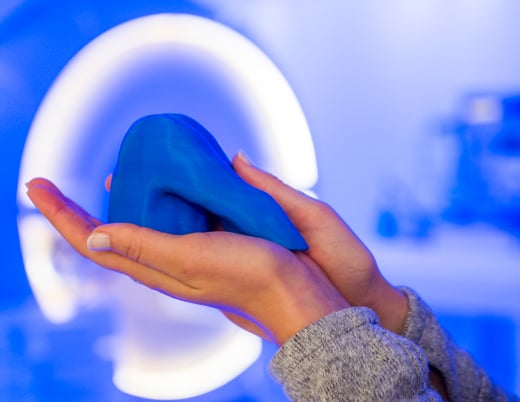Key takeaways
-
Neonatology researchers at Children’s Colorado are pioneers in the animal and clinical study of metabolism in the growth-restricted fetus.
-
While their earlier animal study found giving fetuses more amino acids increased insulin secretion, this study showed the role that a single amino acid, leucine plays.
-
These findings help further the understanding of the precise nutrients controlling pancreatic development and insulin secretion.
Research background: determining which amino acid mixture potentiates GSIS
In a previous study, neonatology researchers in the Perinatal Research Center at Children’s Hospital Colorado and the University of Colorado School of Medicine showed that amino acids and glucose act synergistically to stimulate the secretion of fetal insulin. Other studies showed individual amino acids could stimulate insulin secretion in fetal sheep, but none tested the capacity of individual amino acids to potentiate glucose-stimulated insulin secretion (GSIS).
The study at Children’s Colorado did not clearly identify which amino acid mixture was the most important one to increase fetal insulin secretion. There are many reasons why leucine could be the responsible amino acid; one is because it deeply stimulates insulin secretion in late-gestation fetal sheep and isolated fetal sheep islets in vitro.
Study authors sought to determine the impact from a nine-day leucine infusion into a late-gestation sheep fetus, adjusted to achieve a 50 to 100% increase in fetal arterial plasma leucine concentrations, on fetal insulin concentrations, insulin secretion and pancreatic morphology. They hypothesized the leucine infusion would potentiate GSIS in fetal sheep.
Research methods: infusion of leucine and control
The fetal sheep in the study were at 126 days gestational age. Nine received a nine-day leucine infusion to achieve a 50 to 100% increase in leucine concentrations by day three, and eight received a control infusion.
After the infusions, researchers measured GSIS, pancreatic structure and expression of pancreatic mRNAs.
Pancreatic islet endothelial cells (ECs) were isolated from four late-gestation fetal sheep and incubated with supplemental leucine or vascular endothelial growth factor A (VEGFA) and then mRNA was collected.
Research results: impact of leucine and control infusions on fetuses
Maternal and fetal metabolites, blood gases and hormones during infusion
Leucine-infused fetuses (LEU) received increasing rates of leucine infusions during the study. Fetal arterial plasma leucine was the only fetal amino acid concentration significantly affected.
Fetal insulin and glucagon secretion at the end of infusion
Glucose-stimulated insulin concentrations were 80% higher in LEU fetuses than in controls (P < 0.05).
Fetal and organ characteristics
The proportion of male and female fetuses were similar in both groups, and there were no differences between the control and LEU group for fetal weight and length and placental weight.
Fetal pancreatic histology
In the pancreas, compared to controls, LEU fetuses had:
- higher proportion of islets >5000 μm2 (75% more islets >5000 μm2; P < 0.05)
- larger proportion of the pancreas that stained for β cells (12% greater; P < 0.05)
- 25% greater pancreatic and pancreatic islet vascularity (P < 0.05)
Fetal pancreatic VEGFA and HGF
mRNA expressions in LEU fetuses increased over controls:
- by 38% for pancreatic vascular endothelial growth factor A (VEGFA) (P < 0.05)
- by 200% for hepatocyte growth factor (P < 0.05)
After testing the role of leucine and VEGFA in regulating HGF expression in the isolated pancreatic islet endothelial cells, study authors found HGF mRNA was increased by:
- 20% after incubation in supplemental leucine (P < 0.05)
- 50% after incubation in VEGFA (P < 0.01)
Research discussion and conclusion: effect of increasing fetal leucine concentrations
New and important findings from this study include:
- Fetal insulin concentrations during the hyperglycemic clamp were almost twice as high after the chronic leucine infusion compared to the control fetuses.
- The larger islet size and more vascularized islets resulted in a larger area of the pancreases that stained positive for insulin (β cells), and higher total pancreatic vascularity in the LEU fetuses, likely contributing to the higher GSIS in the LEU fetuses
- The increase of fetal leucine concentrations for nine days increased pancreatic HGF and VEGFA mRNA, which are important paracrine regulators of fetal pancreatic islet growth, vascularity and function
To the knowledge of the study authors, this the first study to demonstrate that increasing fetal leucine concentrations potentiates fetal GSIS and leads to increased fetal pancreatic islet size, vascularity and β cells. The study, combined with previous findings, shows glucose and amino acids act in harmony to stimulate fetal insulin secretion, and that leucine has an important stimulating effect on fetal pancreatic islet development and fetal β-cell function, outside of an increase in the concentrations of other amino acids or glucagon. This is important for the regulation of fetal growth by nutrients, as insulin is one of the most important anabolic growth factors in the latter part of gestation.
Future studies will determine the relative contribution of different cellular and molecular pathways to leucine’s regulatory role for fetal insulin secretion and the development of the pancreas and pancreatic islet.





 720-777-0123
720-777-0123










